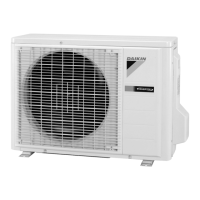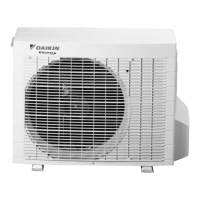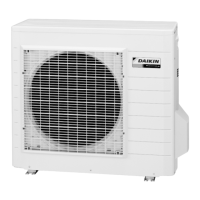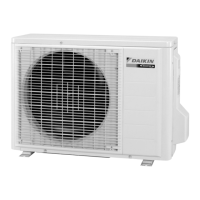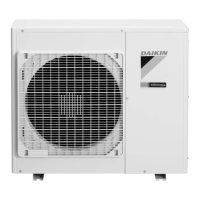Do you have a question about the Daikin RKS25E2V1B and is the answer not in the manual?
Lists the available functions and features of the air conditioning units.
Explains how the air conditioner should be operated and handled after installation.
Provides instructions on operating the air conditioner.
Details the procedure for conducting trial operation of the air conditioner.
Covers settings required for specific installation scenarios and functions.
Provides essential safety warnings and precautions for repair and handling of the equipment.
Explains the meaning of icons used throughout the manual for better understanding.
Lists detailed technical specifications for the air conditioning units.
Provides specifications for the cooling-only models of the air conditioner.
Provides specifications for the heat pump models of the air conditioner.
Details the wiring diagrams for the printed circuit boards of the indoor and outdoor units.
Describes the primary functions and operational modes of the air conditioner.
Explains the role and function of thermistors in the system's operation.
Details the control specifications and logic governing the air conditioner's operation.
Explains how the air conditioner should be operated and handled after installation.
Provides instructions on operating the air conditioner.
Explains the functions and layout of the remote control unit.
Details how to select and operate different modes like Auto, Dry, Cool, Heat, and Fan.
Describes how to adjust the airflow direction using the louvers and flaps.
Explains the POWERFUL operation mode for maximizing cooling or heating capacity.
Describes the function to reduce noise from the outdoor unit.
Details the HOME LEAVE operation for recording and recalling preferred settings.
Explains how to use the timer functions for automatic operation.
Provides essential cautions and warnings before performing diagnostic procedures.
Lists common symptoms and their corresponding measures for troubleshooting.
Offers detailed troubleshooting steps for various error codes and malfunctions.
Explains how to troubleshoot based on the blinking patterns of the operation lamp and LED A.
Details a specific method for checking the remote control's error codes for the ARC433 series.
Provides a list of error codes and their descriptions for system diagnosis.
Describes the diagnosis and troubleshooting steps for an abnormal indoor unit PCB.
Explains the protection controls related to freezing and peak heating loads.
Details troubleshooting for issues related to the AC fan motor and its abnormalities.
Covers troubleshooting for thermistor issues within the indoor unit.
Addresses troubleshooting for errors in signal transmission between indoor and outdoor units.
Explains troubleshooting for unspecified voltage issues between the indoor and outdoor units.
Guides on diagnosing and resolving abnormalities in the outdoor unit PCB.
Details troubleshooting for compressor overload (OL activation) issues.
Provides troubleshooting steps for compressor lock errors.
Explains how to troubleshoot DC fan lock errors.
Covers troubleshooting for input overcurrent detection in the system.
Details troubleshooting steps for abnormalities in the four-way valve.
Explains the control mechanism for discharge pipe temperature and related issues.
Describes the high-pressure control logic and troubleshooting in cooling mode.
Guides on diagnosing abnormalities in the compressor system sensors.
Explains troubleshooting for position sensor abnormalities in the compressor start-up.
Covers troubleshooting for DC voltage/current sensor abnormalities.
Details troubleshooting for thermistor-related abnormalities in the outdoor unit.
Explains the detection and troubleshooting of temperature rise in the electrical box.
Addresses temperature rise issues related to the radiation fin and their troubleshooting.
Explains the detection and troubleshooting of output overcurrent in the system.
Details the detection and troubleshooting of refrigerant shortage.
Covers troubleshooting for low-voltage or over-voltage detection in the system.
Provides methods for checking various components of the air conditioning system.
Details the procedure for checking the electronic expansion valve (EV).
Explains how to check the performance of the four-way valve.
Describes how to measure the resistance of thermistors for diagnosis.
Outlines checks for proper installation conditions of the outdoor unit.
Details the procedure for checking the discharge pressure of the system.
Explains how to check the outdoor fan system for proper operation.
Describes how to check power supply waveforms for abnormalities.
Covers checks related to the refrigerant system of inverter units.
Details the procedure for checking the power module.
Explains how to check rotation pulses on the outdoor unit PCB.
Describes the procedure for checking the Hall IC.
Provides steps for checking the main circuit for short circuits.
Provides instructions for removing components of the indoor unit.
Details the steps for removing the air filter and front grille.
Explains how to remove the front panel of the indoor unit.
Describes the procedure for removing the horizontal blade (flap) of the indoor unit.
Details the removal of the signal receiver unit and the swing motor.
Explains the steps for removing the discharge grille of the indoor unit.
Provides instructions for removing the drain pan from the indoor unit.
Details the removal of the electrical box and the PCB from the indoor unit.
Explains how to remove the fan rotor and the fan motor from the indoor unit.
Describes the procedure for removing the indoor heat exchanger.
Provides removal procedures specific to the RK(X)S25/35E2V1B outdoor unit.
Details the removal of outer panels and the fan motor from the outdoor unit.
Explains the steps for removing the electrical box from the outdoor unit.
Provides instructions for removing the PCB from the outdoor unit.
Details the removal of the reactor and partition plate from the outdoor unit.
Explains how to remove the sound blanket from the outdoor unit.
Provides instructions for removing the four-way valve.
Details the procedure for removing the compressor from the outdoor unit.
Provides removal procedures specific to the RK(X)S25/35G2V1B outdoor unit.
Details the removal of outer panels and the fan motor from the outdoor unit.
Explains the steps for removing the electrical box from the outdoor unit.
Provides instructions for removing thermistors from the outdoor unit.
Details the removal of the PCB from the outdoor unit.
Details the removal of the reactor and partition plate from the outdoor unit.
Explains how to remove the sound blanket from the outdoor unit.
Provides instructions for removing the four-way valve.
Details the procedure for removing the compressor from the outdoor unit.
Provides removal procedures specific to the RK(X)S25/35G2V1B9 outdoor unit.
Details the removal of outer panels and the fan motor from the outdoor unit.
Explains the steps for removing the electrical box from the outdoor unit.
Provides instructions for removing the PCB from the outdoor unit.
Details the removal of the reactor and partition plate from the outdoor unit.
Explains how to remove the sound blanket from the outdoor unit.
Provides instructions for removing the four-way valve.
Details the procedure for removing the compressor from the outdoor unit.
Contains diagrams illustrating the piping connections for the air conditioning system.
Provides wiring diagrams for the indoor and outdoor units of the air conditioner.
Lists the available functions and features of the air conditioning units.
Explains how the air conditioner should be operated and handled after installation.
Provides instructions on operating the air conditioner.
Details the procedure for conducting trial operation of the air conditioner.
Covers settings required for specific installation scenarios and functions.
Provides essential safety warnings and precautions for repair and handling of the equipment.
Explains the meaning of icons used throughout the manual for better understanding.
Lists detailed technical specifications for the air conditioning units.
Provides specifications for the cooling-only models of the air conditioner.
Provides specifications for the heat pump models of the air conditioner.
Details the wiring diagrams for the printed circuit boards of the indoor and outdoor units.
Describes the primary functions and operational modes of the air conditioner.
Explains the role and function of thermistors in the system's operation.
Details the control specifications and logic governing the air conditioner's operation.
Explains how the air conditioner should be operated and handled after installation.
Provides instructions on operating the air conditioner.
Explains the functions and layout of the remote control unit.
Details how to select and operate different modes like Auto, Dry, Cool, Heat, and Fan.
Describes how to adjust the airflow direction using the louvers and flaps.
Explains the POWERFUL operation mode for maximizing cooling or heating capacity.
Describes the function to reduce noise from the outdoor unit.
Details the HOME LEAVE operation for recording and recalling preferred settings.
Explains how to use the timer functions for automatic operation.
Provides essential cautions and warnings before performing diagnostic procedures.
Lists common symptoms and their corresponding measures for troubleshooting.
Offers detailed troubleshooting steps for various error codes and malfunctions.
Explains how to troubleshoot based on the blinking patterns of the operation lamp and LED A.
Details a specific method for checking the remote control's error codes for the ARC433 series.
Provides a list of error codes and their descriptions for system diagnosis.
Describes the diagnosis and troubleshooting steps for an abnormal indoor unit PCB.
Explains the protection controls related to freezing and peak heating loads.
Details troubleshooting for issues related to the AC fan motor and its abnormalities.
Covers troubleshooting for thermistor issues within the indoor unit.
Addresses troubleshooting for errors in signal transmission between indoor and outdoor units.
Explains troubleshooting for unspecified voltage issues between the indoor and outdoor units.
Guides on diagnosing and resolving abnormalities in the outdoor unit PCB.
Details troubleshooting for compressor overload (OL activation) issues.
Provides troubleshooting steps for compressor lock errors.
Explains how to troubleshoot DC fan lock errors.
Covers troubleshooting for input overcurrent detection in the system.
Details troubleshooting steps for abnormalities in the four-way valve.
Explains the control mechanism for discharge pipe temperature and related issues.
Describes the high-pressure control logic and troubleshooting in cooling mode.
Guides on diagnosing abnormalities in the compressor system sensors.
Explains troubleshooting for position sensor abnormalities in the compressor start-up.
Covers troubleshooting for DC voltage/current sensor abnormalities.
Details troubleshooting for thermistor-related abnormalities in the outdoor unit.
Explains the detection and troubleshooting of temperature rise in the electrical box.
Addresses temperature rise issues related to the radiation fin and their troubleshooting.
Explains the detection and troubleshooting of output overcurrent in the system.
Details the detection and troubleshooting of refrigerant shortage.
Covers troubleshooting for low-voltage or over-voltage detection in the system.
Provides methods for checking various components of the air conditioning system.
Details the procedure for checking the electronic expansion valve (EV).
Explains how to check the performance of the four-way valve.
Describes how to measure the resistance of thermistors for diagnosis.
Outlines checks for proper installation conditions of the outdoor unit.
Details the procedure for checking the discharge pressure of the system.
Explains how to check the outdoor fan system for proper operation.
Describes how to check power supply waveforms for abnormalities.
Covers checks related to the refrigerant system of inverter units.
Details the procedure for checking the power module.
Explains how to check rotation pulses on the outdoor unit PCB.
Describes the procedure for checking the Hall IC.
Provides steps for checking the main circuit for short circuits.
Provides instructions for removing components of the indoor unit.
Details the steps for removing the air filter and front grille.
Explains how to remove the front panel of the indoor unit.
Describes the procedure for removing the horizontal blade (flap) of the indoor unit.
Details the removal of the signal receiver unit and the swing motor.
Explains the steps for removing the discharge grille of the indoor unit.
Provides instructions for removing the drain pan from the indoor unit.
Details the removal of the electrical box and the PCB from the indoor unit.
Explains how to remove the fan rotor and the fan motor from the indoor unit.
Describes the procedure for removing the indoor heat exchanger.
Provides removal procedures specific to the RK(X)S25/35E2V1B outdoor unit.
Details the removal of outer panels and the fan motor from the outdoor unit.
Explains the steps for removing the electrical box from the outdoor unit.
Provides instructions for removing the PCB from the outdoor unit.
Details the removal of the reactor and partition plate from the outdoor unit.
Explains how to remove the sound blanket from the outdoor unit.
Provides instructions for removing the four-way valve.
Details the procedure for removing the compressor from the outdoor unit.
Provides removal procedures specific to the RK(X)S25/35G2V1B outdoor unit.
Details the removal of outer panels and the fan motor from the outdoor unit.
Explains the steps for removing the electrical box from the outdoor unit.
Provides instructions for removing thermistors from the outdoor unit.
Details the removal of the PCB from the outdoor unit.
Details the removal of the reactor and partition plate from the outdoor unit.
Explains how to remove the sound blanket from the outdoor unit.
Provides instructions for removing the four-way valve.
Details the procedure for removing the compressor from the outdoor unit.
Provides removal procedures specific to the RK(X)S25/35G2V1B9 outdoor unit.
Details the removal of outer panels and the fan motor from the outdoor unit.
Explains the steps for removing the electrical box from the outdoor unit.
Provides instructions for removing the PCB from the outdoor unit.
Details the removal of the reactor and partition plate from the outdoor unit.
Explains how to remove the sound blanket from the outdoor unit.
Provides instructions for removing the four-way valve.
Details the procedure for removing the compressor from the outdoor unit.
Contains diagrams illustrating the piping connections for the air conditioning system.
Provides wiring diagrams for the indoor and outdoor units of the air conditioner.
| Category | Air Conditioner |
|---|---|
| Model | RKS25E2V1B |
| Type | Split System |
| Cooling Capacity | 2.5 kW |
| Energy Efficiency Ratio (EER) | 3.21 |
| Energy Efficiency Ratio (Heating) | 3.61 |
| Refrigerant | R32 |
| Outdoor Unit Dimensions (W x H x D) | 658 x 550 x 275 mm |
| Power Supply | 220-240 V, 50 Hz |
| Noise Level (Outdoor Unit) | 49 dB(A) |
